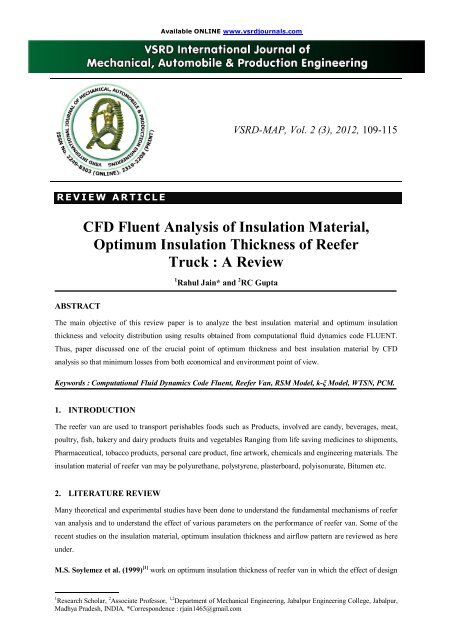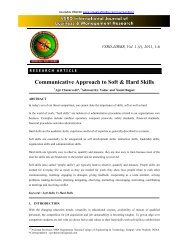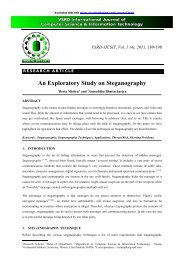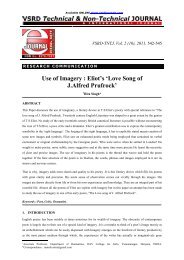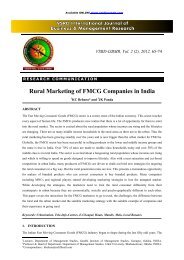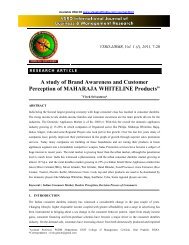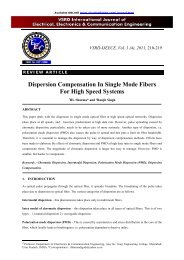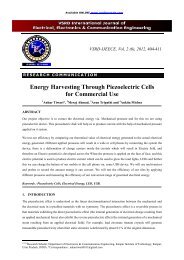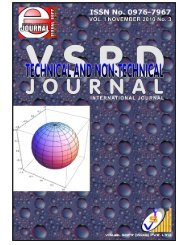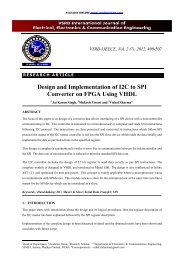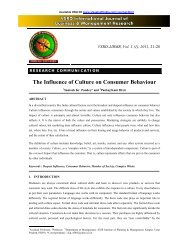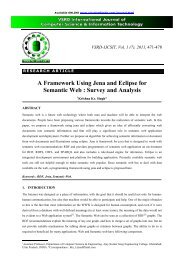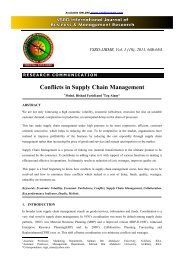CFD Fluent Analysis of Insulation Material, Optimum Insulation - vsrd ...
CFD Fluent Analysis of Insulation Material, Optimum Insulation - vsrd ...
CFD Fluent Analysis of Insulation Material, Optimum Insulation - vsrd ...
Create successful ePaper yourself
Turn your PDF publications into a flip-book with our unique Google optimized e-Paper software.
Available ONLINE www.<strong>vsrd</strong>journals.comVSRD-MAP, Vol. 2 (3), 2012, 109-115R E V II E W A R T II C L E<strong>CFD</strong> <strong>Fluent</strong> <strong>Analysis</strong> <strong>of</strong> <strong>Insulation</strong> <strong>Material</strong>,<strong>Optimum</strong> <strong>Insulation</strong> Thickness <strong>of</strong> ReeferTruck : A Review1 Rahul Jain* and 2 RC GuptaABSTRACTThe main objective <strong>of</strong> this review paper is to analyze the best insulation material and optimum insulationthickness and velocity distribution using results obtained from computational fluid dynamics code FLUENT.Thus, paper discussed one <strong>of</strong> the crucial point <strong>of</strong> optimum thickness and best insulation material by <strong>CFD</strong>analysis so that minimum losses from both economical and environment point <strong>of</strong> view.Keywords : Computational Fluid Dynamics Code <strong>Fluent</strong>, Reefer Van, RSM Model, k-ξ Model, WTSN, PCM.1. INTRODUCTIONThe reefer van are used to transport perishables foods such as Products, involved are candy, beverages, meat,poultry, fish, bakery and dairy products fruits and vegetables Ranging from life saving medicines to shipments,Pharmaceutical, tobacco products, personal care product, fine artwork, chemicals and engineering materials. Theinsulation material <strong>of</strong> reefer van may be polyurethane, polystyrene, plasterboard, polyisonurate, Bitumen etc.2. LITERATURE REVIEWMany theoretical and experimental studies have been done to understand the fundamental mechanisms <strong>of</strong> reefervan analysis and to understand the effect <strong>of</strong> various parameters on the performance <strong>of</strong> reefer van. Some <strong>of</strong> therecent studies on the insulation material, optimum insulation thickness and airflow pattern are reviewed as hereunder.M.S. Soylemez et al. (1999) [1] work on optimum insulation thickness <strong>of</strong> reefer van in which the effect <strong>of</strong> design____________________________1 Research Scholar, 2 Associate Pr<strong>of</strong>essor, 1,2 Department <strong>of</strong> Mechanical Engineering, Jabalpur Engineering College, Jabalpur,Madhya Pradesh, INDIA. *Correspondence : rjain1465@gmail.com
Rahul Jain et al / VSRD International Journal <strong>of</strong> Mechanical, Auto. & Prod. Engg. Vol. 2 (3), 2012parameters on the optimum insulation thickness are investigated for three test cities using an interactivecomputer code written in FORTRAN 77. Author made comparative study type <strong>of</strong> insulation in which Authorcompare cost and thermal conductivity in which thermal conductivity minimum for urethane (0.021W/m° C)and maximum for perlite (0.054 W/m° C) and cost minimum for fiberglass batt (38.14 $/m 3 )and maximum forfiberglass rigid (313.59 $/ m 3 ) lastly Author conclude that maximum savings takes place at 70mm <strong>of</strong> urethaneinsulation thickness and the optimum insulation decreases continuously with increasing thermal conductivitycost, except for this critical point and optimum insulation thickness inversely proportional to thermalconductivity cost <strong>of</strong> insulating material.W. R. da Veiga et al. (2002) [2] conduct experimental work in that thermocouples placed all around the vehiclesuch that one thermocouple was placed in the centre <strong>of</strong> the container and six other thermocouples were placedon the inner face <strong>of</strong> each <strong>of</strong> the container walls. Experimental work to determine heat transfer and Author findthat heat transfer coefficient varies from 5.15 W/m 2 k to 2.73 W/m 2 k and the average heat transfer coefficient is3.80 W/m 2 k.Tso et al. (2002) [3] used a commercial <strong>CFD</strong> program to model the effect <strong>of</strong> door openings on air temperaturewithin a refrigerated truck. A series <strong>of</strong> experiments to study the effect <strong>of</strong> door openings with air curtains andwith plastic strip curtains after two minutes the door was opened the average air temperatures was stated to haverisen from -10 to 14 ° C. The <strong>CFD</strong> simulation generally overestimated the temperature rise by 3 and 4 °c. AndAuthor concludes that the difference was due to the effect <strong>of</strong> condensing water vapour in the experimentalsituation.J. Moureh et al. (2002) [4] Compare experimental and numerical data in which Author used <strong>CFD</strong> to study theairflow by the code FLUENT on a reduced scale model (1:3.3) <strong>of</strong> a trailor. In their study, a second-momentclosure, the Reynolds stress model (RSM) and two equation turbulence models: the standard k-epsilon and arenormalization group (RNG), were tested and compared with experimental data. And Author find that thetemperature <strong>of</strong> compartment entrance is lowest and while behind body is highest and decreases in velocity frominlet section .Author also find that the wall jet separates from the ceiling at approximately 10 m in the case <strong>of</strong> anempty enclosure and 5 m in the loaded configuration. This separation splits the jet into two regions dominatedby two vortices <strong>of</strong> opposite circulation. Airflow separation due to Coanda effect.Stubbs et al. (2004) [5] developed numerical model for the length <strong>of</strong> time a foodstuff packed in an expandedpolystyrene box with a coolant could remain below 8 or 5 ° C. Author assumed that product will be deliveredwithin 24 hours <strong>of</strong> posting this was the only configuration that would maintain the product below 8° C whilesthe ambient temperature up to 30 ° C.Spence et al. (2004) [6] used a simple model to help in the initial development <strong>of</strong> an air cycle refrigeration unit.The unit developed was <strong>of</strong> the physical size and power as the conventional unit but in its unoptimised state itconsumed far more power .Author also show that there can be considerable differences in the refrigerationperformance <strong>of</strong> nominally similar transport refrigeration units when vehicles engines are idling, i.e. when thevehicles are moving slowly or stationary. The work was extended to look at the effect <strong>of</strong> air distribution.Qingshan Shan et al. (2005) [7] work on wireless temperature sensor network (WTSN) for refrigerated vehicle.110
Rahul Jain et al / VSRD International Journal <strong>of</strong> Mechanical, Auto. & Prod. Engg. Vol. 2 (3), 2012At the time <strong>of</strong> driving driver don’t know what’s the inside temperature <strong>of</strong> refrigerated cabin. So to solve thisproblem sensors were placed at key positions and temperature display in front <strong>of</strong> driver by temperature sensor,so that driver notes the temperature at regular interval. Author concludes that the prototype <strong>of</strong> WTSNtechnologies and mathematical model are feasible, reliable and accurate. And future work still needed to furtherinvestigate into WTSN using artificial intelligence technologies for data management.S. J. James et al. (2006) [8] work on modeling <strong>of</strong> refrigerated van. With varying thickness from 25mm to 200mmAuthor plot a graph for heat extracted by refrigeration plant and Author find that with increase in thickness heatextracted continuously decreases and that only a small thickness <strong>of</strong> insulation greatly reduces the amount <strong>of</strong> heatto be extracted. Author also work on the rate <strong>of</strong> heat extract from the van, averaged over the periods when thevehicle is moving as the function <strong>of</strong> the number <strong>of</strong> stops the van makes. Author find one important differencebetween cold stores and refrigerated transport systems are that transport containers are not static and conditionsare affected by vehicle speed and orientation in relation to factors such as the sun. In their study Authorcalculate that the heat extracted from a poorly sealed van was 86% more than from a well-sealed van.Silvia Estrada et al. (2006) [9] in their experiment Author proposed that automatic air temperature monitoringequipment should be fitted to all refrigerated delivery vehicle. A thermocouple was placed in the centre <strong>of</strong> thecontainer and six other thermocouples were placed on the inner face <strong>of</strong> each <strong>of</strong> the container walls. The testswere conducted early in the morning to ensure a low ambient temperature. Author proposed that temperaturevariability was not related with effectiveness <strong>of</strong> the insulation nor the time required achieving complete cooling<strong>of</strong> the cargo space but temperature variability was correlated with the time required for the unit to recovertemperature control after a door opening and the difference between the maximum and minimum temperaturesreached during a door opening cycle. Author also finds that the temperature <strong>of</strong> compartment entrance is lowestand while behind body is highest. And lastly Heat flow in vertical direction is obvious quicker than in horizontaldirection.Alain Kondjoyan et al. (2006) [10] did comparative study <strong>of</strong> pork, loin, lamb, beef carcass. Author also didcomparative study between turbulence intensity conditions and air velocities. For turbulence intensity conditionvaries from 5% to 40% than air velocities varies from 2m/s to 4.4 m/s. Author also work on effect <strong>of</strong> differentfactors on average heat transfer coefficient values effect on air velocities. K-ξ models describe isotropicturbulences. K-ξ models valid for high turbulent Reynolds number. Author found that difficulty in generating aconstant temperature or constant heat flux on entire solid surface and the requirement <strong>of</strong> complete 3d flux ortemperature measurement. Author Compare experimental and numerical data and Author find that the decreasein velocity from the inlet section.Pieter Verboven et al. (2006) [11] did <strong>CFD</strong> analysis on sphere, potato, cheese, beetroot, orange, Mandarin,Tomato, apple and potato. So Author makes comparative analysis between velocity, porosity and Reynoldsnumber. In <strong>CFD</strong> analysis Author used K-ξ model. Author calculates contours <strong>of</strong> pressure (Pascal), velocity(m/s), turbulent kinetic energy (m 2 /s 2 ) and velocity vector. Author conclude that transport phenomenon arecomplicated by shape and size variation <strong>of</strong> many food products, the thermo physical properties <strong>of</strong> refrigeratedfoods and presence <strong>of</strong> turbulence during forced convection cooling. The direct <strong>CFD</strong> modeling <strong>of</strong> transportphenomenon in food bulks will help in design and optimization <strong>of</strong> refrigeration systems.111
Rahul Jain et al / VSRD International Journal <strong>of</strong> Mechanical, Auto. & Prod. Engg. Vol. 2 (3), 2012Smale et al. (2006) [12] used Numerical modelling techniques to Prediction <strong>of</strong> airflow pattern. Experimentalresults can be successfully coupled with <strong>CFD</strong> to validate results and obtain most reliable evaluation <strong>of</strong> airflowpattern. <strong>Fluent</strong> analysis with the RSM turbulence model to predict the three dimensional airflow patterns withina refrigerated vehicle. <strong>CFD</strong> code Kameleon used to predict pressure and velocity distribution.Hongbo et al. (2006) [13] this paper is concerned with heat transfer and Phase Change <strong>Material</strong> (PCM).Calculated results were verified by experimental measured data. Author work for cryogenic range i.e. below -150°c. Numerical study has been conducted by using Computational Fluid Dynamics (<strong>CFD</strong>) code FLUENT.Author fined that larger biot no. is beneficial to heat transfer PCM and coolantDong Wang et al. (2006) [14] <strong>Analysis</strong> is conducted by comparing mass flow flux,static pressure coefficient overvan inlet and streamlines.Cooling performance is very sensitive.Prototype minivan with good agreement <strong>of</strong>desired cooling performance.Use FLUENT <strong>CFD</strong> code.Airflow distribution analysis.Francisco et al. (2006) [15] prepare computational fluid dynamic model <strong>of</strong> the heat and moisture transfer duringbeef chilling. Author made mathematical model after that using boundary conditions Author work on <strong>CFD</strong>modeling .Author find relation between time and temperature are inversely proportional .lastly Author concludethat <strong>CFD</strong> predicted local temperature variation <strong>of</strong> up to 9° C and water activity variation <strong>of</strong> up to 9% around thebeef surface.Hui Jin et al. (2006) [16] done testing and modeling <strong>of</strong> under floor air supply plenums. Author done bothexperimental and <strong>CFD</strong> simulation and then Author made comparative study. In experimental study Author usetype T thermocouples and control system were installed to monitor air temperatures at the plenum inlet, floordiffusers, and selected locations inside the plenum and in <strong>CFD</strong> Author work on airflow pattern, air temperaturedistribution, and heat transfer from above and below plenum. Author used various governing equations andboundary conditions. Author work finely on airflow pattern, air velocity, temperatures at diffusers. Theirfindings are the magnitude <strong>of</strong> heat flux is associated with air velocity and air temperature, since convective heattransfer is a product <strong>of</strong> convective coefficient and temperature difference, Air velocity has its highest velocityand lowest temperature at inlet; obviously, heat flux decreases gradually after airflow enters and air velocity islow compared with inlet velocity. Lastly Author conclude the model was validated using experimental datacollected in a full scale plenum test facility and the computed air temperature, velocity ,and heat flux generatedagree well with the measured data.Teshome et al. (2006) [17] work on a zonal model in which direct and indirect approach <strong>of</strong> <strong>CFD</strong> to calculateairflow pattern. And Author fined that both clockwise and anticlockwise air circulation in zonal. Authorconcludes that MPLM (modified power-law model with variable k) is much better than PLMK (power-lawmodel with variable k).Zhijian Liu et al. (2007) [18] work on correlation between indoor air distribution and pollutants in naturalventilation. k-ξ model is used to determine the turbulent kinematic viscosity. The temperature and RH weretaken as the reference variable in the process <strong>of</strong> sampling. Author conclude that air distribution should bepredicted depending on <strong>CFD</strong> simulation before construction ,so as to avoiding the unreasonable designing andpoor air quality , mechanical ventilation should be employed when large population density. Author also fined112
Rahul Jain et al / VSRD International Journal <strong>of</strong> Mechanical, Auto. & Prod. Engg. Vol. 2 (3), 2012that lower airflow velocity and unreasonable air distribution because <strong>of</strong> some vortexes existing.Fu-Yun Zhao et al. (2008) [19] perform the experiment in which simulating the airflow in the studied room.Three dimensional airflow numerical models are developed to predict air motion within an enclosure. Authorsimulates the three dimensional static airflow and temperature distribution by <strong>CFD</strong> code FLUENT. Author usedRSM turbulence model to predict air motion. And Author proposed that flow rate <strong>of</strong> non-symmetrical solutionsis significantly greater than that <strong>of</strong> symmetrical solutions.S.A. Tassou et al. (2009) [20] performed <strong>Insulation</strong> efficiency (heat leakage) test by the inner heating method,and Performance tests <strong>of</strong> the refrigeration system. Author found Losses are structural pockets, air gaps, metalliclatches, structural ribs, hinges, rivets or screws. Author talk about Reefer van Insulated with high quality, lowconductivity material for example polyurethane. Author found that Properties <strong>of</strong> insulation directly proportionalto age <strong>of</strong> vehicle and Reduction in CO 2 emissions by hybrid systems. Reduction in the cost <strong>of</strong> insulation willreduce the refrigeration load. Author also find that COP increases 0.4 to 0.62 after 9 years <strong>of</strong> operation resulting50 % increase in energy consumption and CO 2 emission. The COP <strong>of</strong> transport refrigeration systems is quitelow, ranging for around 0.5 at 20 ° C. Author proposed that further research work and development work isneeded to improve efficiency and reduce weight.Li Xiaoyan et al. (2010) [21] study on new cool storage material for refrigerated vehicle in cold chain and workon optimisation <strong>of</strong> logistic chain and Author proposed that a correct approach to weight losses is a primary goalin cold chain. The insulation material used was polyurethane. Author talk about fresh food supply chain,transportation devices, storage, mainly in order to achieve the purpose <strong>of</strong> preservation, thus Author talk aboutcold chain logistics. Author find problem that most <strong>of</strong> the phase change material thermal conductivitycoefficient is small, small cop <strong>of</strong> compressor, reducing consumption <strong>of</strong> refrigeration system.Lastly Authorproposed that strengthening mechanism <strong>of</strong> thermal conductivity also needs depth theoretical analysis.Shouhao Li et al. (2011) [22] did numerical simulation <strong>of</strong> cooling structure by <strong>CFD</strong> code FLUENT. Authorassumes the air flow in air duct is three dimensional problems. Using boundary conditions Author done analysison duct and Author conclude that uniformity air flow has great benefit to the temperature <strong>of</strong> the battery.Table 1 : Comparative Work Done By Various AuthorsAuthor Journal Year Approach FindM.S.SoylemezW. R. daVeigaELSEVIER 1999 EXPERIMENTALOPTIMUMINSULATIONTHICKNESSTurbulenceModelN/ACodeUsedN/AApplicationRefrigeratedTruckELSEVIER 2002 EXPERIMENTAL HEAT TRANSFER N/A N/A Snow bagC.P Tso ELSEVIER 2002 <strong>CFD</strong> AIRFLOW PATTERN K-ξ FLUENTJ. Moure ELSEVIER 2002D.M.StubbsS.W.TSpenceQingshanShanTeshome<strong>CFD</strong>+EXPERIMENTALAIRFLOW PATTERNK-ξ+RSMFLUENTELSEVIER 2004 <strong>CFD</strong> AIRFLOW PATTERN K-ξ FLUENTELSEVIER 2004 <strong>CFD</strong> AIRFLOW PATTERN K-ξ FLUENTIEEE 2005 EXPERIMENTAL WTSN NA N/ARefrigeratedcontainerRefrigeratedTruckRefrigeratedcontainerRefrigeratedcontainerRefrigeratedcontainerELSEVIER 2006 <strong>CFD</strong> AIRFLOW PATTERN K-ξ FLUENT ZonalS. J. James ELSEVIER 2006 <strong>CFD</strong> <strong>Insulation</strong> thickness K-ξ FLUENT Refrigerated113
Rahul Jain et al / VSRD International Journal <strong>of</strong> Mechanical, Auto. & Prod. Engg. Vol. 2 (3), 2012and heat transferSilviaTEMPERATUREEstrada ELSEVIER 2006 EXPERIMENTALFROMN/A N/ATHERMOCOUPLESAIRFLOW PATTERNAlainELSEVIER 2006 <strong>CFD</strong>AND HEAT MASSKondjoyanTRANSFERK-ξ FLUENTPieterVerboven ELSEVIER 2006 <strong>CFD</strong> AIRFLOW PATTERN K-ξ FLUENTN.J. SmaleDong WangHui JinFranciscoZhijian LiuELSEVIER 2006 <strong>CFD</strong> AIRFLOW PATTERN K-ξFLUENT+kamelonIEEE 2006 <strong>CFD</strong> AIRFLOW PATTERN K-ξ FLUENTcontainerRefrigeratedTruckRefrigeratedcontainerRefrigeratedcontainerRefrigeratedTruckRefrigeratedroomASHRAE 2006 <strong>CFD</strong> AIRFLOW PATTERN K-ξ FLUENT PlenumASHRAE 2006 <strong>CFD</strong> AIRFLOW PATTERN K-ξ FLUENT PlenumIEEE 2008 <strong>CFD</strong> AIRFLOW PATTERN RSM PhoneticsFu-YunZhao ELSEVIER 2009 <strong>CFD</strong> AIRFLOW PATTERN K-ξ FLUENTS.A.Tassou ELSEVIER 2009 EXPERIMENTALLi XiaoyanHongboShouhao LiIEEE 2010 EXPERIMENTALELSEVIER 2011 <strong>CFD</strong>INSULATIONMATERIAL-PUFFCOOL STORAGEMATERIALPCM FREEZING OFCRYOGENIC GASN/AN/AK-ξN/AN/AFLUENTIEEE 2011 <strong>CFD</strong> AIRFLOW PATTERN K-ξ FLUENTSlotventilatedenclosureRefrigeratedcontainerRefrigeratedTruckRefrigeratedcontainerRefrigeratedcontainerRefrigeratedcontainer3. CONCLUSIONThe insulation material, airflow pattern and optimum insulation thickness <strong>of</strong> reefer can be found out bysimulation and experimental results. Maximum journal used fluent code and maximum work done on airflowpattern. Polyurethane is the best insulation material and the optimum insulation thickness was 70mm formaximum efficiency <strong>of</strong> reefer truck.4. FUTURE WORKTo find pull up time and pull down time readings by experimental work. To find best insulation material fromcomparative study <strong>of</strong> insulation material by <strong>CFD</strong> results. To find optimum insulation thickness.5. REFERENCES[1] M.S. Soylemez, <strong>Optimum</strong> insulation thickness for refrigeration applications (1999) 13-21[2] W. R. da Veiga, Heat transfer coefficient <strong>of</strong> a snow bag (2002) 1043-1046[3] C.P Tso, Experimental study on the heat and mass transfer characteristics in a refrigerated truck (2002)340-350[4] J. Moureh , Numerical and experimental study <strong>of</strong> airflow in a typical refrigerated truck configuration loadedwith pallets (2002) 25-42[5] D.M.Stubbs, wrapping strategies for temperature control <strong>of</strong> chilled foodstuffs during transport (2004) 69-80[6] S.W.T Spence, construction and testing <strong>of</strong> air-cycle systems for road transport (2004) 503-510[7] Qingshan Shan Wireless temperature sensor network for refrigerated vehicles (2005) 985-994[8] S. J. James, Modeling <strong>of</strong> food transportation systems a review (2006) 947-955114
Rahul Jain et al / VSRD International Journal <strong>of</strong> Mechanical, Auto. & Prod. Engg. Vol. 2 (3), 2012[9] Silvia Estrada Thermal performance indicators for refrigerated road vehicles (2006) 889-898[10] Alain Kondjoyan (2006) A review on surface heat and mass transfer coefficients during air chilling andstorage <strong>of</strong> food products 863-875[11] Pieter Verboven, Modelling transportation phenomena in refrigerated food bulks, packages and stacks:basics and advances (2006) 985-997[12] N.J.Smale, A review <strong>of</strong> numerical models <strong>of</strong> airflow in refrigerated food applications (2006) 911-930[13] Dong Wang ,<strong>CFD</strong> Predictions <strong>of</strong> Minivan's Front-end Flow Performance (2006) 34-39[14] Francisco, A computational fluid dynamic model <strong>of</strong> the heat and moisture transfer during beef chilling(2006) 998-1009[15] Hui Jin, Testing and modeling <strong>of</strong> under floor air supply plenums (2006) 581-591[16] Teshome, A new generation <strong>of</strong> zonal models (2006) 163-175[17] Zhijian Liu, Correlation between indoor air distribution and pollutants in natural ventilation (2007) 21-26[18] Fu-Yun Zhao, Multiple steady fluids flows in a slot-ventilated enclosure (2008) 1295-1308[19] S.A. Tassou, Food transport refrigeration – Approaches to reduce energy consumption and environmentalimpacts <strong>of</strong> road transport (2009) 1467-1477[20] Li Xiaoyan, Study <strong>of</strong> New Cool Storage <strong>Material</strong>s for Refrigerated Vehicle in Cold Chain (2010) 637-640[21] Shouhao Li, the Natural Ventilation System Study on Electric Vehicle (2011) 5236-5237[22] Hongbo, Simulation research on PCM freezing process to recover and store the cold energy <strong>of</strong> cryogenicgas (2011) 1-8115


